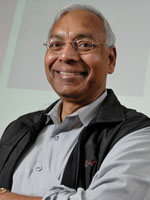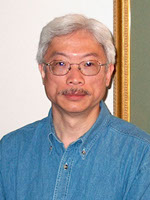


EVENT : KEYNOTES



Anil K. Jain
Michigan State University
Bing-Hwang (Fred) Juang
Georgia Institute of Technology
Kenji Shimada
Carnegie Mellon University
Biometrics: Technology for Human Recognition
Abstract
If you are like many people, navigating the complexities of everyday life depends on an array of cards and passwords that confirm your identity. But lose a card, and your ATM will refuse to give you money. Forget a password, and your own computer may balk at your command. Allow your card or passwords to fall into the wrong hands, and what were intended to be security measures can become the tools of fraud or identity theft. Biometrics—the automated recognition of people via distinctive anatomical and behavioral traits—has the potential to overcome many of these problems.
Biometrics is not a new idea. Pioneering work by several British scholars, including Fauld, Galton and Henry in the late 19th century established that fingerprints exhibit a unique pattern that persists over time. This set the stage for the development of Automatic Fingerprint Identification Systems (AFIS) that are now used by law enforcement agencies worldwide. The success of fingerprints in law enforcement coupled with growing concerns related to homeland security, financial fraud and identity theft has generated renewed interest in research and development of biometric systems. It is, therefore, not surprising to see biometrics permeating our society (laptops and mobile phones, border crossing, e.g., US-VISIT program, civil registration, e.g., unique ID (UID) project in India, and entrance to Disney parks). Despite these successful deployments, biometrics is not a panacea for human recognition. There are challenges related to data acquisition, image quality, robust matching, multi-biometrics, system security and user privacy. This talk will address some of these challenges in the context of fingerprint matching, face recognition, use of soft biometrics (scars, marks and tattoos) and biometric template security.
Biography
Anil K. Jain is a University Distinguished Professor in the Departments of Computer Science & Engineering, and Electrical & Computer Engineering at Michigan State University. He received a B.Tech. degree from IIT, Kanpur (1969) and M.S. and Ph.D. degrees from Ohio State University in 1970 and 1973, respectively. His research interests include pattern recognition, computer vision and biometric recognition. His articles on biometrics have appeared in Scientific American, Nature, IEEE Spectrum, Comm. ACM, IEEE Computer1,2, Proc. IEEE1,2, Encarta, Scholarpedia, and MIT Technology Review.
He has received a number of awards, including Guggenheim fellowship, Humboldt Research award, Fulbright fellowship, IEEE Computer Society Technical Achievement award (2003), IEEE W. Wallace McDowell award (2007), IAPR King-Sun Fu Prize (2008), and IEEE ICDM 2008 Research Contribution Award for contributions to pattern recognition and biometrics. He also received the best paper awards from the IEEE Trans. Neural Networks (1996) and the Pattern Recognition journal (1987, 1991, 2005). He served as the Editor-in-Chief of the IEEE Trans. Pattern Analysis and Machine Intelligence (1991-1994). He is a Fellow of the ACM, IEEE, AAAS, IAPR and SPIE.
Holder of six patents in the area of fingerprints (transferred to IBM in 1999), he is the author of several books, including Introduction to Biometrics (2011), Handbook of Biometrics (2007), Handbook of Multibiometrics (2006), Handbook of Face Recognition (first edition: 2005; second edition 2011), Handbook of Fingerprint Recognition (first edition: 2003, second edition: 2009) (received the PSP award from the Association of American Publishers), Markov Random Fields: Theory and Applications (1993), and Algorithms For Clustering Data (1988). ISI has designated him as a highly cited researcher (his h-index is 128). According to CiteSeer, his book, Algorithms for Clustering Data is ranked # 91 in the Most Cited Articles in Computer Science (over all times) and his paper "Data Clustering: A Review" (ACM Computing Surveys, 1999) is consistently ranked in the Top 10 Most Popular Magazine and Computing Survey Articles Downloaded.
He is serving as a member of the National Academies panel on Information Technology and previously served on panels on Whither Biometrics and Improvised Explosive Devices (IED). He also served as a member of the Defense Science Board.
Quantification and Transmission of Information and Intelligence -
History and Outlook
Abstract
One of the most important achievements of the humankind is the ability to communicate remotely, now almost without bounds, in time, in distance as well as in modes. The history of the technical development that led to the current achievement is intriguing and yet inspiring, although at times confusing because the term communication may encompass notions of varying sophistication, from simple delivery of data and reconstruction of information, to measurement of articulation, retention of intelligibility, comprehension, and ultimately inference of intelligence. This talk intends to reminisce this fascinating history in hope of helping to set a new launching pad for the next challenge of the information age, whatever that may be.
Biography
Professor Juang received his Ph.D. from University of California, Santa Barbara in 1981. He had worked at Speech Communications Research Laboratory (SCRL) and Signal Technology, Inc. (STI) on a number of Government-sponsored research projects. Notable accomplishments during the period include development of vector quantization for voice applications, voice coders at extremely low bit rates, 800 bps and around 300 bps, and robust vocoders for use in satellite communications. He subsequently joined the Acoustics Research Department of Bell Laboratories, working in the area of speech enhancement, coding and recognition. Prof. Juang became Director of Acoustics and Speech Research at Bell Labs in 1996, and Director of Multimedia Technologies Research at Avaya Labs (a spin-off of Bell Labs) in 2001. His group continued the long heritage of Bell Labs in speech communication research, including, most notably, the invention of electret microphone, network echo canceller, a series of speech CODECs, and key algorithms for signal modeling and automatic speech recognition. In the past few years, he and his group developed a speech server for applications such as AT&T's advanced 800 calls and the Moviefone, the Perceptual Audio Coder (PAC) for digital audio broadcasting in North America (in both terrestrial and satellite systems), and a world-first real-time full-duplex hands-free stereo teleconferencing system. Prof. Juang has published extensively, including the book “Fundamentals of Speech Recognition”, co-authored with L.R. Rabiner, and holds about twenty patents. He joins Georgia Tech in 2002.
Redundancy Meets Efficacy – Robotic Path Optimization
Abstract
In some engineering problems, the most desirable solutions can be found by strategically adding redundancy in the system or including redundancy in the problem formulation. In this talk we demonstrate this concept by applying it to the robotic path optimization problem for: (1) a robotic cell consisting of a 6DOF manipulator and a turntable; and (2) an unmanned aerial vehicle for visual inspection. In the former, the turntable adds one more DOF making the entire robotic cell kinematically redundant with 7DOF. In the latter, redundancy is included in the problem formulation by allowing a range of positions and configurations of an UAV in inspecting each target. We model the path optimization problem as a Traveling Salesman Problem with Neighborhoods (TSPN), which extends the well-known TSP to more general cases where each target point is allowed to move in a given region, or a neighborhood. A hybrid random-key Genetic Algorithm (GA) is employed to find a near-optimal tour for this NP-hard optimization problem. Compared with conventional methods, the proposed method can shorten the distance traveled and reduce energy consumption significantly, by 20-40% for the tested cases in our work.
Biography
Dr. Kenji Shimada is the Theodore Ahrens Professor in Engineering at Carnegie Mellon University in the Department of Mechanical Engineering, the Department of Biomedical Engineering (courtesy appointment), the Department of Civil and Environmental Engineering (courtesy appointment), and the Robotics Institute (courtesy appointment). Dr. Shimada received his B.S. and M.S. from the University of Tokyo, and his Ph.D. from the Massachusetts Institute of Technology. His research interests are in the areas of geometric modeling, computational geometry, computer graphics, factory robotics, computer and robot assisted surgery, and human body simulation. Prior to joining Carnegie Mellon in 1996, he was Manager of Graphics Applications at IBM Research, Tokyo Research Laboratory. At IBM Research Dr. Shimada initiated and led various research and consultation projects with IBM customers and the Japanese government, as well as with the company’s internal product development and manufacturing groups. At Carnegie Mellon, Dr. Shimada has explored a new physically based approach to key geometric problems in engineering and medical applications, such as finite element mesh generation, interactive curve and surface design, three-dimensional shape reconstruction, robotic path generation, and surgical planning. His physically based mesh generation method, BubbleMesh®, has been licensed to and used by over 80 companies in manufacturing industries. A member of ACM, ASME, IEEE Computer Society, JSIAM, and SAE, Dr. Shimada is the recipient of a number of awards, including International Meshing Roundtable Fellow Award in 2011, Best Author Award from the Japan Society for Industrial and Applied Mathematics in 2006, ASME Design Automation Best Paper Award in 2004, IPSJ Best Paper Award in 2002, NSF CAREER Award in 2000, Honda Initiation Grant Award in 1998, George Tallman Ladd Award for Excellence in Research from the Carnegie Institute of Technology in 1998, IPSJ Yamashita SIG Research Award in 1994, and Nicograph Best Paper Award in 1994. Shimada currently serves on the editorial board of four international journals and has served as Chairman of many academic conferences and committees, including Geometric Modeling and Processing in 2006, ASME Design Automation Conference in 2004, Symposium on Unstructured Mesh Generation in 2001, and International Meshing Roundtable in 1999. He is the author or co-author of over 150 peer-reviewed papers in journals and conferences, and the inventor or co-inventor of over 20 patents in the US, Japan, and Europe.


